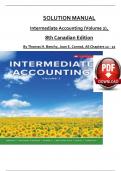Examen
Solution Manual for Intermediate Accounting (Volume 2), 8th Canadian Edition By Thomas H. Beechy, Joan E. Conrod, Verified Chapters 12 - 22, Complete Newest Version
- Cours
- Établissement
Solution Manual for Intermediate Accounting (Volume 2), 8th Canadian Edition By Thomas H. Beechy, Joan E. Conrod, Verified Chapters 12 - 22, Complete Newest Version Solution Manual for Intermediate Accounting (Volume 2), 8th Canadian Edition By Thomas H. Beechy, Joan E. Conrod, Verified Chapters...
[Montrer plus]



